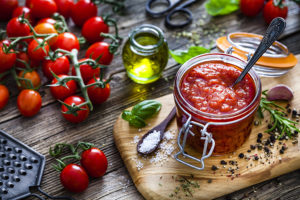
In these golden days of late summer and early fall, garden vines are bursting with ripe tomatoes.
There are a lot of good, nutritional reasons to indulge in this harvest bounty, Sarah VanEerden, RD, a Spectrum Health dietitian who works in preventive cardiology and cardiovascular rehabilitation, said.
“One reason I love tomatoes is they are so versatile,” she said. “You can eat them cold or chopped just by themselves, as a condiment or as a feature of a meal. And they bring color to the plate, as well.”
She offered diverse ways to add tomatoes to your diet—and reasons to do so.
But first: Is a tomato a fruit or a vegetable?
“Botanically, tomatoes are a fruit,” VanEerden said. “A fruit is any vegetable with seeds inside.”
That includes cucumbers, peppers and zucchinis.
“However, nutritionally, we consider them a non-starchy vegetable,” she added. “They bring fiber and antioxidants to the plate.
“They are not considered a carbohydrate like a fruit such as a banana would be. They don’t have a significant amount of fructose.”
Two good reasons to eat tomatoes: vitamin C and potassium.
One medium tomato contains about 30% of the recommended daily allowance of vitamin C, which supports immune system function.
It also contains about 8% percent of the recommended intake for potassium, which helps with blood pressure management.
“Most Americans get enough vitamin C but not enough potassium,” VanEerden said.
Fighting free radicals
Tomatoes also contain a healthy dose of a well-known antioxidant, lycopene.
“We have free radicals floating around in our bodies—naturally produced or from the environment, or from the processed foods we eat,” she said.
“Lycopene is like a little soldier that helps us take care of that and fight that oxidation.”
Research has shown lycopene consumption helps support the immune system, and it’s also linked to lower risk of anti-inflammatory diseases such as cancer, heart disease and arthritis.
Olive oil and tomatoes make a healthy nutritional pairing, VanEerden added.
“The healthy fats of olive oil help us absorb the lycopene,” she said.
In general, tomatoes are low on carbohydrates and protein. A medium tomato delivers about 22 calories.
A whole tomato, however, delivers about 2 grams of fiber—and many of us need a fiber boost. Most fall far short of the recommended 24 grams of fiber daily for women and 38 grams for men, VanEerden said.
In general, tomatoes are a great way to balance your plate, she said.
“We need to fuel our bodies with quality calories from whole foods,” she said.
Tomatoes are considered a nightshade—a fruit or vegetable belonging to a family of plants known by the Latin name, Solanaceae.
Although some people say nightshade vegetables cause inflammation and could exacerbate a condition like arthritis, VanEerden said that is not the case for most people—tomatoes deliver many benefits.
“For most of us, they are anti-inflammatory,” she said. “There is a small subset of people who will become more inflamed with nightshades. That is something to talk to your provider about.”
Tomatoes on the menu
VanEerden offered her favorite ways to add tomatoes to a healthy diet:
- Chop them and add fresh herbs, olive oil, vinegar and optional cucumber.
- Add tomatoes to a cooked whole grain, such as brown rice or quinoa. Add a little paprika and garlic.
- Roast them in the oven at 400 degrees, on a rimmed baking sheet with olive oil. This works with whole cherry tomatoes or larger tomato slices.
- Make fresh tomato soup, adding roasted red peppers, garlic, a little vinegar, herbs and crushed red pepper. You can use a blender to puree it to a slightly chunky texture.
- Explore different cuisines. We often think of Italian dishes when it comes to tomatoes, but they star in salads, soups, stews and dishes from other regions around the world. VanEerden likes to make a Greek dish combining tomatoes with chickpeas, lemon and dill.
- Buy tomatoes in bulk and cook them with or without the skin as a base for spaghetti marinara or other dishes. Freeze or can the sauce.
“Tomatoes never taste as good as they do when they are fresh from the garden,” VanEerden said.
But you can still get the tasty nutritional benefits year-round with canned or jarred tomatoes. With store-bought canned tomatoes, she advises checking the sodium content and buying unsalted tomatoes.
 /a>
/a>
 /a>
/a>
 /a>
/a>